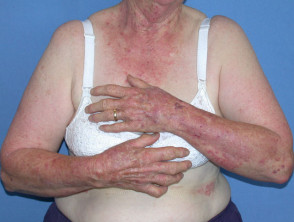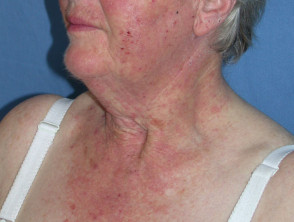| Common name: | Chrysanthemum |
| Botanical name: | X dendranthema |
| Family: | It is part of the very large Asteraceae (Compositae) family. |
| Origin: | The chrysanthemum is a hybrid genus, which has been in cultivation in Asia for over 2000 years. Originally cultivated in China as an herb, chrysanthemums are now grown over the whole world, with many larger towns and cities having Chrysanthemum Societies. There are over 200 species in the genus, which includes annuals, small shrubs, and herbaceous perennials. |
| Description: | Chrysanthemums are related to dahlias, sunflowers, marigolds, zinnias and cosmos. A single bloom is made up of hundreds of flowers called florets. Two kinds of florets are present, disk florets and ray florets. On a daisy type chrysanthemum the outer parts are ray florets and the centre or eye is composed of disk florets. |
Airborne contact dermatitis due to chrysanthemum allergy
| Uses: | Ornamental flower. As an herb, it was believed by the Chinese to have the power of life. Legend has it that the boiled roots were used as a headache remedy; young sprouts and petals were eaten in salads; and leaves were brewed for a festive drink. |
| Allergens: | Chrysanthemums contain a variety of allergens including sesquiterpene lactones. The allergens are borne on the surface of the flowers and leaves, often in the trichomes (plant hairs) which means that they can easily become airborne. |
| Allergy: | Contact dermatitis from chrysanthemum often starts on the fingertips (from removing flower buds) but usually spreads to the forearms and face. It can sometimes be very persistent and has been associated with the development of chronic actinic dermatitis (a severe form of photosensitivity dermatitis). Chrysanthemums are the commonest cause of occupational dermatitis to compositae plants, affecting horticulturalists and florists, but many amateur gardeners are also at risk. Contact urticaria has also been reported following exposure to chrysanthemums; this is an itchy rash occurring within minutes of direct contact with the plant, which settles within an hour or so. |
| Cross reactions: | If you are allergic to chrysanthemums, you unfortunately must remove all chrysanthemums and other members of the Asteraceae (Compositae) family from both your house and garden because even tiny quantities of the allergen in the pollen can cause a reaction on exposed skin. |
| Other information: | |
| Patch test: | Sesquiterpene lactones |

